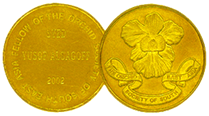- OSSEA
- November 17, 2011
- Posted in

It seems barely yesterday that the 20th World Orchid Conference (WOC) was under way. Actually, it is 11 months ago as this article is written. It took up to eight years of preparation, from the submission of a written proposal and the site visit by the WOC Trustees, and it will take a little longer before a final account is presented in the shape of the Proceedings of the Conference. The Proceedings will be a more comprehensive account: this brief article cannot be more than a sketch, in which, in the interim, I would like to briefly summarise some impressions of this event. The previous Singapore WOC, help in 1963, transformed the local orchid scene. Will this latest WOC do likewise? I am unsure, but hope it may. The Malayan Orchid Review (MOR) is, after all, the journal of the Orchid Society of South-East Asia (OSSEA). So I also want to file some report of the contribution of OSSEA to the show, in the form of its Gold Medal-winning display and the plants therein; an, of course, to illustrate the whole thing and thus evoke pleasant memories of the event.
For it needs to be stressed that by any measure this was a successful WOC, and though demanding and onerous in the preparation, with many uncertainties arising from working in an unfamiliar venue, an enjoyable experience once the day arrived. A World Orchid Conference has become, nowadays, a combined show and conference. It was not always so. In 1963, when the 4th WOC came to Singapore, it was just that, a conference. It was followed by a show put up by the Malayan Orchid Society, as OSSEA then was, but that show was exclusively organised and judged by the MOS. It just happened to coincide with the WOC. Today, in some minds, the WOC has become a giant show, with an added conference component. In fact, in 2011 the show was described as the ‘World Orchid Show’ to distinguish it from the Conference, though both fell under a common 20th WOC Organising Committee, chaired by Dr. Kiat Tan.
A brief word about the Conference part of the WOC is in order. WOC’s, as overall events, aim to reflect the best traditions of combining orchid science with orchid cultivation and appreciation, because historically, scientists and horticulturists, both amateur and professional, have been important in the understanding of orchids. When Darwin published his ground-breaking book on orchid pollination in 1862, the distinction between amateurs and professionals hardly existed. This inclusiveness of all aspects of orchid science and culture was reflected in the planning of the conference. It was therefore specifically planned that there would be three simultaneous tracks or streams; one catering for orchid scientists, one for general interest and grower concerns, and one for special interest symposia or forums, some scientific, others hobby-focused. The result was a registration of 1,058 conference delegated from 51 countries, in every continent, and the presentation to them of 122 papers and 65 posters, on every conceivable aspect of orchids.
As regards the Show, it was enormous, covering 12,000sqm and entirely filling two basement expo halls in the Sands Convention Centre. The Show featured a total of 614 displays from 32 countries in five continents. These displays competed and were judged in five different categories, including Landscape Displays (Division I), Plants & Flowers (Division II), Floral Arrangements (Division III), Art & Craft (Division IV) and Websites & Posters (Division V). The Show also featured education panels and displays including orchid stamps, the orchid album, historical figures, pollination videos and panels with interesting facts on orchids, as an effort to interest the general public in the diversity of orchids and the need to conserve them.
As can be seen from the floor plan of the Show, the landscape displays were arranged in a radial pattern from a focal display in the form of a Giant World Map outlined on the floor of the hall. This map comprised large planters filled with orchids representative of their respective regions, and for this innovation concept the Singapore Botanical Gardens won a Gold Medal. The whole display lay under a huge and beautiful ceiling centrepiece comprising a giant orchid flower some 20m across.
Moving out from this into a series of concentric avenues the visitor encountered a succession of displays ranging from 100sqm to 30sqm, together with table-top displays and floral windows. All the individual plants were judged within their respective displays, and all those with plants but no display put them in the OSSEA display, which thus combined members’ plants with those of visitors. The Grand Champion Display was a 50sqm display from Thailand, exhibited by Chaiwathana Orchid Garden Co. Ltd., and the runner up, a 100sqm display exhibited by The Orchid Society of Papua New Guinea Inc. The former was outstanding for its artistic arrangement and plant quality, the latter for its stunning use of giant masks and other artifacts – which had already come to represent the typical PNG contribution to Singapore Shows.
The quality of the show extended to all parts. At the most remote corner fo the show the Agri-Veterinary Authority (AVA) of Singapore put up a Gold-Meda-Winning 100sqm display with a strongly educational focus, winning the trophy for best educational display. Education was, in fact, a subtheme of this Show, with numerous educational exhibits scattered among the displays. Videos of orchid pollinators at work prepared by Peter O’Byrne and Ong Poh Teck were in this category and were watched with fascination by members of the public. Other peripheral but major displays included the floral arrangements, including the ikebana and the very extensive schools arrangements, plus the art and photographic displays.
There were 200 classes in Divisions I & II of the schedule (landscape and individual plant sections), 190 of them being for plants. All orchids anywhere in the show were considered by the Judges. The list of ribbon and trophy winners is therefore very long. I confine myself to mentioning the only top winners. The Grand Champion was Cycnodes Taiwan Gold ‘Orchis’, exhibited by Orchis Floriculturing Inc, Taiwan. Cycd.Taiwan Gold is now listed by the International Orchid Register as a synonym, but it remains the winner of record. The Reserve Grand Champion was Paphiopedilum Du Motier ‘Victorial Village’, exhibited by the Eric Yong Orchid Foundation. The title of Best Species went to Dendrobium lasianthera, exhibited by Neo Cheng Soon Farm, while the best hybrid was, of course, also the Grand Champion. The best specimen plant was a magnificent specimen of Vana lamellate exhibited by the Singapore Botanic Gardens in the World Map.
When it came to landscapes, OSSEA, as the host, put up a non-competitive display, but other Singapore competitors won competitive trophies. Best Tabletop or Floral Window Trophy went to Tropifame Floral Design School, which also won a Silver medal. Best 30sqm or Smaller Landscape Trophy awarded to Jason Ong (Bronze Medal), and the Trophy for the Best Society or Amateur Display went to the Singapore Gardening Society (Silver Medal) for a stunning 50sqm masterminded by Tan Jiew How, who went on to win a Gold Medal for the Society’s exhibit at the Singapore Orchid Show 2012 show.
As well as the show and the conference, there was a social programme, the most important item of which was the Gala Dinner held in the newly completed Flower Dome within the Gardens by the Bay, just a shuttle bus ride away. This massive and spectacular glass house had been specially planted for a preview to coincide with the WOC, and it was a major attraction over the show period, as well as providing an absolutely unforgettable setting for the dinner. This was not the closing event as has usually been the case, but rather, an awesome and evocative start to a memorable show and conference.



